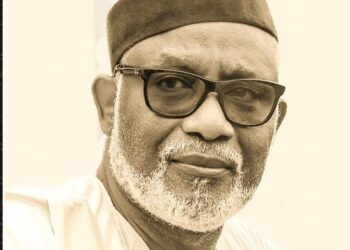
When, following a military coup in 1983, the draconian military authorities under Gen. Muhammad Buhari imposed sanctions on social activities they deemed a reflection of lack of discipline – including independent filmmaking in Kano – all eyes, literally, turned to the TV for both local and foreign programs. The trailblazing film activities of Sani Lamma, Hamisu Gurgu, Sidiya Abubakar and Sidi Musa abruptly stopped. Sani Lamma simply converted to a video coverage business, as well as selling both foreign and Nigerian VHS video tapes – a process that made his collection not only huge but also priceless over time. Hamisu opened a cinema in which he screened foreign and local TV film that he could acquire from TV stations. Sidi Musa converted his poetic skills to composing panegyric poems on the Prophet Muhammad. Sidiya simply became a business woman.
Earlier, in 1981, the Kano State government (under Peoples Redemption Party, PRP) had established a TV station, eventually CTV to tell its own story, as the TV station owned by the Federal government of Nigeria, NTA, was under the control of the rival ruling party, National Party of Nigeria (NPN). The Government of Kano felt that due to the rivalry between the two political parties, its programs were suppressed at the Federal level, thus the need for its own station. The establishment of CTV67 (now Abubakar Rimi Television, ARTV) by the Kano State Government under Abubakar Rimi was the main catalyst in the creation of what eventually became what I call Commercial Kannywood. The term ‘commercial’ is critical, because it reflected the beginning of a business (even though not a profession; for a profession requires standard rules of engagement agreed upon by an accredited technical body). The experimental films by Sani Lamma and his colleagues were not really meant to be commercially sold – just made by a bunch of high-spirited young men with equipment and gumption to produce independent films, just for the hell of it, without expecting any dividends.

In the first quarter of 1983 CTV began broadcasting a two year Hausa drama series that was to set in motion the creation of the core theme of the Hausa video film industry. A team of three producers at CTV had in early 1987 decided to introduce a new drama focused at youth problems of marriage. The producers were Rakiya Sani Ahmed, Salisu Mohammed Galadanci and Abdulƙadir A. Kurawa, famously referred to as “AA Kurawa” (and later to be one of the Director Generals of the Kano State Censorship Board).
The main idea was for a drama series that focus attention on the problems of cousin marriages (auren zumunta) in Hausa societies. The idea being brainstormed at the initial meeting was that such marriages cause a lot of problems for both families when they go wrong. This notion, however, was not accepted by the script team because it was pointed out that families for whom this category of marriage work might take an umbrage at the notion that such marriages were unworkable.
A substitute idea was for a series that focus on materialism of some parents who insist on their daughters or wards marrying someone of their choice because of material benefits—disregarding the wishes of either the boy or the girl. This is a classic Hausa social phenomenon and is often referred to as auren dole (forced marriage). This idea was accepted and shooting started immediately in early 1983 for a CTV drama series to be called “Bakan Gizo”, a Hausa name for rainbow.
In Hausa cosmology, the rainbow is seen as a dehydrator—associated with lack of rain. It usually appears either after raining or after the formation of a heavy rain-cloud. At whatever time it appears, it is seen to stop rain from falling—thus it is seen as “mai tsotse ruwa” (sucking water; in effect dehydrating the clouds). The metaphor is used in the drama to reflect the way a rich man takes away a girl from a boy she loves by giving money to her parents, and making them force her to marry the person, rather than the one she loves. The rich man is therefore the rainbow—taking away the joys of life from the girl.
The series was broadcast in the second quarter of 1983 (April) on Mondays and became an instant hit, especially with women who were quite familiar with the scenario of forced marriage situations, either from individual experience or from the experience of others. Right from the start, it was anticipated that it would be a popular program, and thus it enjoyed a repeat status—the first of its kind in the network—on Thursdays, all at prime time.
“Bakan Gizo” defined the Hausa youth drama by boldly tackling a subject hitherto heard only in folklore and visualized in Hindi films. It dealt with the age-old Hausa obsession with forced marriages (often using Islam as a basis for such forced marriages) and provided Hausa audiences with an opportunity of visually partaking in the imagined world of forced marriages. It was a deconstruction of avaricious nature of people.
The series run from 1983 to 1988, gripping the imagination of urban viewers with its pacifist but anti traditional authority messaging. It was so massively popular such that Islamic clerics decried the times it was shown as they accused the producers of broadcasting it during prayer times – thus delaying people from going to the mosques.
In the meantime, NTA Kano had lost its audiences to CTV67 (as well as its most creative staff). Noting the crowd-pulling power of Bakan Gizo, NTA Kano decided to introduce its own gripping drama to rival Bakan Gizo. In 1986 it created a made-for-TV feature film “Dausayin Soyayya” (The Romantic Pastureland), although the drama was more popularly referred to as “Jamila da Jamilu”, after the main character and his love interest.
“Dausayin Soyayya” drew attention to the most iconic representation of Hausa romantic life—denied love. In the drama, the protagonist, Jamilu, falls in love with Jamila. However, her relatives had other ideas and did not approve of their relationship. Jamilu is subsequently beaten up and in frustration he exiles himself to pastureland in the wilderness, always thinking and longing for Jamila. In a genre defining scene, he sings a love song for her, in absentia, as it were. This is the first Hausa drama to feature an explicit Hindi film influence. It thus entered Hausa popular culture history in being the first televised drama to contain Hindi-style singing from a lovelorn protagonist. But even in this, it merely copied Sidiya Baƙar Indiya’s moves in introducing Hindi film style singing and dancing on Hausa screens, although on an amateur level of filmmaking. Nevertheless, the singing scene in “Dausayin Soyayya” was to signal the beginning of the appearance of the Hindi film motif in Hausa video films in the 1990s.
“Dausayin Soyayya” was basically a clone of Bakan Gizo in that both dealt with romance and parental authority, but without Bakan Gizo’s creative focus. It was meant to draw audiences to NTA Kano – a feat it failed for two reasons. First, it was screened as a single extended episode, thus has no lasting, pulling power. Second, “Bakan Gizo” from CTV was followed up with another popular TV show, “Farin Wata”.
“Farin Wata” (commonly referred to as “Aminu mijin Bose”/Aminu, Bose’s husband), featured perhaps the most innovate screenplay in Hausa drama, for it explored a further configuration of denied love; this time an interface between the affairs of the heart and ethnic loyalties in its creation of love story around a Hausa boy and a Yoruba girl—with parents strenuously opposing. The series’ metaphorical allusion to two virtually mutually exclusive ethnic groups in Nigeria (Hausa and Yoruba) is a reproduction of the immutability of opposing traditional forces—desire and denial—in self-control as it affects the Hausa marriage institution.
At the same time, ‘farin wata’ (part of a maxim: farin wata sha kallo/focal point) refers to the moon being a focus of attention when it is bright in the sky. The idea of a romance between opposing ethnic members, therefore, becomes a focal point, like a bright moon. Both Bakan Gizo and Farin Wata were directed by AA Kurawa often with support from Salisu Galadanci.
Interestingly, some of the actors in “Dausayin Soyayya” migrated to CTV 67 to create “Farin Wata” —further consolidating CTV 67’s media control over the hearts and minds of young Hausa viewers in Kano. “Farin Wata” was so popular that during its broadcast (often after Isha’i late evening) prayers in urban Kano) night-time corner-shop business virtually stood still, with large clusters of viewers huddled around small television sets in front of many shops.
All the three dramas, “Dausayin Soyayya” (boy denied the girl he loves by parents), Bakan Gizo (girl denied the boy she loves by greedy grandmother) and “Farin Wata” (lovers have to fight hostile ethnic chasm) were variations of the same tale, dealing with the issues of denial of choice of partner in a predicated Islamic matrimonial situation. And while not specifically based any Hindi film, nevertheless from the convergence of plot elements between these dramas and popular Hindi films reflecting their perennial love triangles, it is clear to see how urban audience could readily identify not only their personal spaces in the dramas, but also motifs from Hindi films. Their grip—both the dramas and the Hindi films—on the urban audience was sufficiently strong enough to provide a template for then aspiring young actors thinking of transition to the video tape from stage dramas and nascent prose fiction. The linchpin was Aminu Hassan Yakasai.




